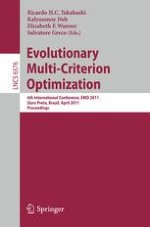This book constitutes the refereed proceedings of the 6th International Conference on Evolutionary Multi-Criterion Optimization, EMO 2011, held in Ouro Preto, Brazil, in April 2011. The 42 revised full papers presented were carefully reviewed and selected from 83 submissions. The papers deal with fundamental questions of EMO theory, such as the development of algorithmically efficient tools for the evaluation of solution-set quality , the theoretical questions related to solution archiving and others. They report on the continuing effort in the development of algorithms, either for dealing with particular classes of problems or for new forms of processing the problem information. Almost one third of the papers is related to EMO applications in a diversity of fields. Eleven papers are devoted to promote the interaction with the related field of Multi-Criterion Decision Making (MCDM).
